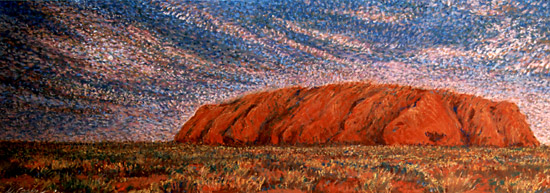

by helen Splarn

Painting by Meridth Cooper
Some months ago the death of one of Uluru’s (Ayers Rock’s) senior traditional owners, led to a national embarrassment for the Northern Territory Chief Minister, Mr. Denis Burke. It showed the true colours of those who are intent on making money out of Uluru regardless of its spiritual significance or respect for those who value it for its true nature.
Mr. Denis Burke personally flew to Alice Springs to urge traditional owners to allow tourists to climb the rock even though it was closed as a sign of respect for the passing of a great man, a man who had encouraged the two cultures to work together for the benefit of all. The man, who cannot be named for cultural reasons, was also a strong supporter of the compromise that allowed visitors to climb Uluru – but only after being told they did so against the wishes of the traditional owners.
This begs the question: “Is the government purely interested in profits, or do they want to enrich the experience of the tourists by helping them appreciate the glory of this ancient and sacred site which is held dear by the traditional owners?”
As with many spiritual beliefs of the creation, the Pitjinjara and Yankajara people known as Anangu believe in 2 levels of the universe, heaven and earth. In the celestial world of Ilkara or heaven reside heroic ancestors. During the creation time Tjurkurpa these heroes lived on earth. They found the spirit or essence in all life.
In the beginning the earth was flat and there were no marks on the land, as the Tjurkurpa people travelled the land they performed great deeds of creation and destruction. This was still the creation time and as the waters receded the Mother earth gave forth a huge rock singular and complete. For thousands of years this rock stood alone in the heart of Australia, as if protecting the Mother earth which had given it life. Gaining its strength and powers from her, vibrating the atmosphere with innocence and peace.
Tjurkurpa is existence itself in the past, present and future. It is the primordial law, which governs behaviour, like the Ten Commandments or a similar code of duty. As time passes the Tjurkurpa and the creation unfold together expressing the evolution of man in spiritual harmony with nature. Guiding man in his destiny by playing the part of that small still voice within – while time acts out the play of the creator and the karma of each man, neither of which can be separated.
When the mythical time came to a natural end features such as rocks, hills and valleys were formed in the places where the Tjurkurpa people had performed great deeds. Their bodies too were transformed into rocks or boulders. Today many of these places, such as Uluru, are known as sacred sites to the Aboriginal people.
Why then do the Country Liberal politicians not respect and support the wishes of the traditional owners, given that Uluru is a spiritual and sacred site, not a commercial venture like some theme park constructed out of nothing? So why has the ban been condemned by Country Liberal politicians including Mr. Burke and Senator Grant Tambling?
The Territory’s leading tour operator said that the attacks on the ban presented a bigger threat to tourism than the ban itself.
“The people visiting Uluru at this point of time have been very understanding,” said AAT Kings sales manager Mr. Peter Kavanagh.
“There’s no reason for anyone to suggest tourism in the Northern Territory is at risk, and comments such as that will do more damage to tourism than closing the climb for a couple of weeks.”
It would seem that the tourists are more in tune with the traditional owners than the politicians who can see no further than the bottom of their pockets.
For the white man, explorer and tourist alike, Uluru represents the essence of Aboriginal dream time, but many of those who see it are also moved by a power which goes far beyond its mere physical presence. So what is the magnet, which attracts 500,000 people a year to this the largest monolith in the world?
Until the early 1900’s the rock held little attraction except for geologists, anthropologists and biologists. By the 1930’s the concept of Uluru as a tourist attraction had been born. In 1959 leases were granted to tour companies and on 24th May 1977 the Ayers Rock and Mount Olga areas were officially declared a National Park.
The tourist trade, which has grown out of white man’s fascination for the rock has caused an abundance of changes to the heart of Australia. The most notable being the construction of the Yulara resort, (situated 17km from the rock and outside the National Park) offering the ultimate in luxury and comfort.
The average stay of a tourist is 1.8 days; they don’t stay long enough to experience the spiritual nature of the rock because they are too busy climbing it.
Each evening visitors make their way to the famous sunset strip to witness a spectacular play of nature. Sunset at Uluru. For many apart from the climb it is the highlight of their stay during their pilgrimage to this: a Mecca in the wilderness. So what is the attraction? Some might argue it is just a huge rock to photograph, climb and conquer. For others it plays host to one of the natural wonders of the world. But one thing is certain: there is a spirit that moves through all mankind linking us to the creation - nowhere else can this be felt more than at Uluru.
AAT Kings, which takes more than 40,000 visitors to the rock each year, has had “virtually no negative feedback”. Instead, Mr. Kavanagh said, “we believe a large number of them see it as an opportunity to personally contribute to preserving the cultural heritage.”
By making people more aware of the spiritual significance of Uluru it is hoped that far from discouraging people, those who do go will experience something far deeper and longer lasting than just a ‘hike up a rock’.
The idea of a permanent ban does not worry Mr. Kavanagh. “My understanding is that should a majority of the people visiting Uluru arrive there with no intention to climb then the climb will be closed.”
The handing back of the rock to the Aboriginal people in October 1985 and the subsequent leasing of the rock to the National Parks and Wildlife created the opportunity for a new direction in tourism – a direction that would enhance the experience of Uluru and the surrounding environment. Uluru is an expression of the creation, taking us back to our roots. It is more sublime than a rock to be climbed simply because it is there.
The Uluru-Kata Tjuta park manager, Mr. Brooke Watson, said the dead man was senior custodian of the Tjurkurpa, or Aboriginal traditional law. “He was also the leading philosopher behind the joint management of the park and led us all through how that should work” he said.
“He was very realistic about the need to keep it open until we can educate the majority of people, and thus an eventual closure would not impact upon the revenue of operators, of the park and of the Anangu people who are direct recipients of income from the park”.
Many who see Uluru are in awe of its power – to face the rock is to ask fundamental questions about ones own place in the creation, for the spirit of man dwells in all men equally. Different races share different dreams yet the essence of life is common to all transcending the barriers of time, race, religion and culture. To deny the spiritual significance of Uluru is to deny the essence of life within ourselves.
Back to Issue 22
©Copyright Knowledge of Reality Magazine 1996-2006. All rights reserved.
Any comments, queries please email us.